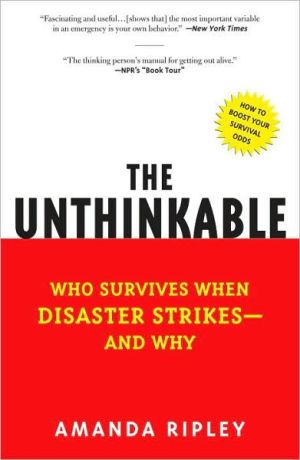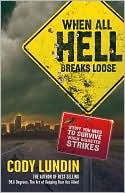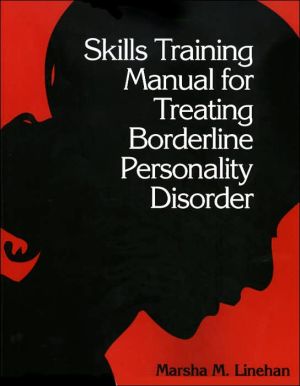The Unthinkable: Who Survives When Disaster Strikes - and Why
Discover how human beings react to danger–and what makes the difference between life and death\ Today, nine out of ten Americans live in places at significant risk of earthquakes, hurricanes, tornadoes, terrorism, or other disasters. Tomorrow, some of us will have to make split-second choices to save ourselves and our families. How will we react? What will it feel like? Will we be heroes or victims?\ In her quest to answer these questions, award-winning journalist Amanda Ripley traces human...
Search in google:
Discover how human beings react to danger–and what makes the difference between life and deathToday, nine out of ten Americans live in places at significant risk of earthquakes, hurricanes, tornadoes, terrorism, or other disasters. Tomorrow, some of us will have to make split-second choices to save ourselves and our families. How will we react? What will it feel like? Will we be heroes or victims? In her quest to answer these questions, award-winning journalist Amanda Ripley traces human responses to some of recent history’s epic disasters, from the explosion of the Mont Blanc munitions ship in 1917–one of the biggest explosions before the invention of the atomic bomb–to the journeys of the 15,000 people who found their way out of the World Trade Center on September 11, 2001. To understand the science behind the stories, Ripley turns to leading brain scientists, trauma psychologists, and other disaster experts. She even has her own brain examined by military researchers and experiences, through realistic simulations, what it might be like to survive a plane crash into the ocean or to escape a raging fire.Ripley comes back with precious wisdom about the surprising humanity of crowds, the elegance of the brain’s fear circuits, and the stunning inadequacy of many of our evolutionary responses. Most unexpectedly, she discovers the brain’s ability to do much, much better–with just a little help. The Barnes & Noble Review "Most of us, I think, have imagined what it might be like to experience a plane crash or a fire or an earthquake," writes Amanda Ripley in her engaging, enlightening, and surprisingly upbeat The Unthinkable: Who Survives When Disaster Strikes -- and Why. "We have ideas about what we might do or fail to do, how it might feel for our hearts to pound in our chests, whom we might call in the final moments, and whether we might be suddenly compelled to seize the hand of the businessman sitting in the window seat. We have fears that we admit to openly and ones that we never discuss. We carry around this half-completed sentence, filling in different scenarios depending on the anxiety of the times: I wonder what I would do if "
Chapter 1\ Delay: Procrastinating in Tower 1\ On February 26, 1993, when terrorists attacked the World Trade Center for the first time, Elia Zedeno was in an express elevator carrying a slice of Sbarro's pizza. She had taken a new temporary worker to the food court to show him around, and they were on their way back to their desks. When the bomb exploded, they heard a loud pop and the elevator stopped and began to descend. Then it stopped for good, trapping her and five other people. Smoke began to slowly coil in from below. Two men grappled with the door. A woman dropped to her knees and started praying, making Zedeno nervous. Then one of the men calmly directed everyone to get low and cover their faces. They all did as they were told.\ Zedeno concentrated on keeping her breathing shallow and slow. But the more she tried to calm down, the harder her heart seemed to pound. Then they heard a man screaming in the elevator next to them. "I'm burning up!" he yelled as he banged on the metal box around him. But soon he was quiet. "I remember thinking, 'We're going to be next,'" Zedeno says. She visualized rescue workers finding them dead inside the elevator later. Just then, she thought she would lunge for the doors and start banging herself. But before she could, the temp had started doing it for her. He was screaming and banging. So Zedeno took charge of quieting him down. "Robert, calm down. You're going to inhale too much smoke," she told him. He started to cough and returned to the floor.\ It was around then that Zedeno was filled with a wave of peace, inexplicably. "Regardless of the outcome, I knew everything was going to be OK," she remembers. "My breath became effortless. My mind no longer wandered. Suddenly, I wasn't there anymore. I was just watching. I could see the people lying in the elevator. The sounds were far away, and I was just hovering. I had no emotions."\ When they'd been in the elevator for about an hour, a firefighter managed to rip open the door and pull them out. It turned out the car had returned to the lobby level, and that's where they'd been all along. Zedeno could not see the face of the firefighter who pulled her out; the smoke was too thick. She did as he instructed, grabbing onto a rope and following it out through the lobby and out the doors. She was stunned by the darkness in the lobby and the emptiness outside. She thought that once she had made it out of her own private catastrophe, everything would be normal, bustling and bright. She never imagined that a place could look so different.\ In the basement below, a Ryder truck full of eleven hundred pounds of explosives had left a crater five stories deep. Six people had died. It was the largest full-building evacuation in U.S. history, and nothing had gone the way it was supposed to go. Smoke purled up the stairways. The power failed, rendering the emergency communications system useless and the stairways dark. People moved extraordinarily slowly. Ten hours after the explosion, firefighters were still finding people who had not yet evacuated in their offices.\ After the bombing, glow-in-the-dark tape and backup power generators were installed in the Trade Center. Both helped save lives eight years later. But still no one fully answered the fundamental question: why did people move so slowly? And what did it mean about all of our assumptions about skyscrapers—and the Trade Center in particular? The 1993 bombing became a story about terrorism, as would the attacks on the same buildings eight years later, and rightly so. But they were also stories of procrastination and denial, the first phase of the human disaster experience.\ A few days later, Zedeno was right back at work in a neighboring building. One month later, her office reopened on the seventy-third floor of Tower 1. She started riding the same elevator to work. But it was months before she could get the taste of soot out of her mouth. She thought about leaving the towers, but not with any conviction. "I remember saying, 'This could happen again.' And someone said, 'Lightning never strikes twice.'"\ "Don't Worry. It's in Your Head!"\ Zedeno has a small stature, round glasses, and Dizzy Gillespie cheeks when she smiles, which happens often. She came to America with her family from Cuba when she was eleven. Her parents had spent her entire childhood plotting to get away from Fidel Castro. When they finally got permission to leave in the early 1970s, they moved to West New York, New Jersey, where their daughter could see the brand-new Trade Center Towers sunning themselves almost everywhere she went.\ When she was nineteen, Zedeno visited the Trade Center for the first time. She came to apply for a secretarial job with the Port Authority of New York/New Jersey. She had no idea what the Port Authority did—or even that it owned the Trade Center—but a girlfriend convinced her to fill out the application. When she returned for her second interview, her mother came with her. The boss hired her on the spot, and, on her lunch break, Zedeno ran to the plaza to tell her mother. "What will you do?" she asked her mother, who had no idea how to get home to New Jersey. "I will sit right here and wait for you," her mother announced. They took the train home together that evening.\ Eventually, Zedeno got promoted to the finance section. Her office had regular fire drills, which consisted of gathering in the hallway to gossip. During a blackout in 1990, she and her office mates walked down the tower's stairs. That's how they learned that homeless people had been using the lower stairwells as bathrooms. "We were laughing and talking," she remembers. When Zedeno talks, her voice goes up at the end of her sentences, like a child telling you something outrageous. "The whole thing was a joke!"\ Zedeno is a witness wherever she goes. She remembers life in surround-sound detail. When I ask her what it was like to leave Cuba as a little girl, she tells me about the day she left in April of 1971. Her mother was doing her hair when they heard the sound of a motorcycle. "Only one man in town had a motorcycle, and it didn't sound like that," she says. Suddenly, the sound stopped in front of their house. A soldier walked in the front door without knocking and told them to leave. Zedeno knew this was good news: they had finally won permission to go to America. Fifteen minutes later, they left their house forever. They were terrified the whole journey out, but they made it. When they arrived in Miami, Zedeno ran down the aisles of a supermarket yelling out descriptions of everything she saw.\ By September 2001, Zedeno had worked in the towers for over twenty-one years. She was forty-one years old, and she managed five employees on the seventy-third floor of Tower 1. Her group oversaw the Port Authority's engineering consultants. On 9/11, Zedeno got to work a little after 8:00 A.M. She settled into her cubicle and listened to her voice-mail messages. In an hour, she would head up to the cafeteria to get some breakfast, as usual.\ The Trade Center did not feel like a cluster of seven buildings; it felt like a city. Every day, fifty thousand people came to work there, and another two hundred thousand passed through. The plaza underneath held the largest shopping mall in Lower Manhattan. "You didn't need to leave for anything," Zedeno says. The complex had 103 elevators—and its own zip code (10048). Bomb threats and small fires were not uncommon. The engine company across the street sometimes got called to the Trade Center eight times a day. Zedeno got used to seeing firefighters in the elevators. Days later, she would hear that there had been smoke somewhere in the building. It might have been two football fields away from her.\ At 8:46 A.M., an American Airlines Boeing 767 traveling 490 mph struck the building eleven floors above her. When the plane hit Zedeno's building, the effect was not subtle. It obliterated four floors immediately. From her desk, Zedeno heard a booming explosion and felt the building lurch to the south, as if it might topple. It had never done that before, not even in 1993. This time, she grabbed her desk and held on, lifting her feet off the floor. "I actually expected the ceiling to fall and the building to cave in," she remembers. At the time, she screamed, "What's happening?"\ Talking about it now, in a deli across from the void where the towers once stood, Zedeno wonders why she didn't immediately run for the stairs. She'd been through this before, after all. But what she really wanted, quite desperately, was for someone to answer back: "Everything is OK! Don't worry. It's in your head!" At the moment of impact, Zedeno had entered a rarefied zone. The rules of normal life were suspended. Her entire body and mind changed. She would wind her way through a series of phases along the survival arc. First would be a thicket of disbelief, followed by frantic deliberation, and, finally, action. We will witness all three here, but more than anything else, Zedeno's story is one of denial.\ Zedeno has revisited the moments of her escape from the Trade Center until they are worn and familiar. She now gives tours of Ground Zero to tourists from around the world. But still there are riddles she cannot decipher, behavioral glitches that don't make obvious sense. More than anything else, she is mystified by how slow she was to accept what was happening all day long.\ After the plane hit the building, Zedeno told me, she wanted nothing so much as to stay. Like her, I was perplexed by this reaction. Shouldn't a primal, survival instinct have kicked in, propelling her to the door? I wondered if Zedeno was unusual. So I went to the National Fire Academy to find out. The instructors at the school, located on the rolling grounds of a former Catholic college in rural Maryland, are veteran firefighters who have witnessed just about every conceivable form of human behavior in fire. I met Jack Rowley, who spent thirty-three years as a firefighter in Columbus, Ohio. When I told him about Zedeno, he told me that he saw this kind of curious indifference all the time. In fact, he came to consider one particular kind of fire a regular Saturday night ritual. His station house would get dispatched to a bar; he would walk into the establishment and see smoke. But he would also see customers sitting at the bar nursing their beers. "We would say, 'Looks like there's a fire here,'" he says. He'd ask the customers if they felt like evacuating. "They would say, 'No, we'll be just fine.'"\ One of the few people who has extensively analyzed behavior at the Trade Center in both 1993 and 2001 is Guylene Proulx at Canada's National Research Council. And what she saw fit with Zedeno's memory exactly. "Actual human behavior in fires is somewhat different from the 'panic' scenario. What is regularly observed is a lethargic response," she wrote in a 2002 article in the journal Fire Protection Engineering. "People are often cool during fires, ignoring or delaying their response."\ In a May 19, 2006, column in the Wall Street Journal, Matthew Kaminski wrote about a recent flight he'd taken from Paris to New York. Three hours out of Paris, halfway into the movie Jarhead, Kaminski heard a loud thud and felt the plane shudder and swerve. "The captain made no announcement. No one asked the flight attendants a thing," he wrote. And yet, wrote Kaminski, a veteran traveler, "My stomach told me to worry."\ About an hour later, the pilot announced the plane would be making an emergency landing in St. John's, Newfoundland. It seems one of the plane's four engines had blown out. As the plane approached the landing strip, the passengers could see fire trucks and ambulances on the tarmac below. The French flight attendant's English was deteriorating fast. In a high-pitched voice, she ordered the passengers to "Brace, brace!" And what did about half the passengers do in this moment of exquisite tension? Did they panic or weep or pray to God? No. They laughed.\ The plane, as it turned out, landed safely. And Kaminski was left to marvel at his fellow passengers' well-developed sense of irony.\ Laughter—or silence—is a classic manifestation of denial, as is delay. Zedeno was not alone. On average, Trade Center survivors waited six minutes before heading downstairs, according to a 2005 National Institute of Standards and Technology (NIST) study drawn from interviews with nearly nine hundred survivors. (The average would likely be higher if those who died had been able to respond to the survey.) Some waited as long as forty-five minutes. People occupied themselves in all kinds of interesting ways. Some helped coworkers who were disabled or obese. In Tower 2, many people followed fatal instructions to stay put. Staying inside was, after all, the standard protocol for skyscraper fires. But ultimately, the threat should have demanded immediate attention. Eventually, almost everyone saw smoke, smelled jet fuel, or heard someone giving the order to leave. Even then, many called relatives and friends. About one thousand individuals took the time to shut down their computers, according to NIST. "The building started to sway and everything started shaking," one person on a floor in the sixties of Tower 1 told NIST. "I knew there was something wrong." Notice what comes next: "I ran to my desk and made a couple of phone calls. I dialed about five times trying to reach my [spouse]. I also called my sisters to find out more information."\ Why do we procrastinate leaving? The denial phase is a humbling one. It takes a while to come to terms with our miserable luck. Rowley puts it this way: "Fires only happen to other people." We have a tendency to believe that everything is OK because, well, it almost always has been before. Psychologists call this tendency "normalcy bias." The human brain works by identifying patterns. It uses information from the past to understand what is happening in the present and to anticipate the future. This strategy works elegantly in most situations. But we inevitably see patterns where they don't exist. In other words, we are slow to recognize exceptions. There is also the peer-pressure factor. All of us have been in situations that looked ominous, and they almost always turn out to be innocuous. If we behave otherwise, we risk social embarrassment by overreacting. So we err on the side of underreacting.\ But it would be a mistake to assume that we just waste time during this delay.
Introduction: "Life Becomes Like Molten Metal" vPart 1 Denial 11 Delay: Procrastinating in Tower 1 32 Risk: Gambling in New Orleans 22Part 2 Deliberation 533 Fear: The Body and Mind of a Hostage 554 Resilience: Staying Cool in Jerusalem 855 Groupthink: Role Playing at the Beverly Hills Supper Club Fire 108Part 3 The Decisive Moment 1396 Panic: A Stampede on Holy Ground 1417 Paralysis: Playing Dead in French Class 1638 Heroism: A Suicide Attempt on the Potomac River 179Conclusion: Making New Instincts 203Author's Note 225Appendix 1 How to Boost Your Survival Odds 229Appendix 2 Notes 233Appendix 3 Selected Bibliography 251Index 259
\ Publishers WeeklyRipley, an award-winning writer on homeland security for Time, offers a compelling look at instinct and disaster response as she explores the psychology of fear and how it can save or destroy us. Surprisingly, she reports, mass panic is rare, and an understanding of the dynamics of crowds can help prevent a stampede, while a well-trained crew can get passengers quickly but calmly off a crashed plane. Using interviews with survivors of hotel fires, hostage situations, plane crashes and, 9/11, Ripley takes readers through the three stages of reaction to calamity: disbelief, deliberation and action. The average person slows down, spending valuable minutes to gather belongings and check in with others. The human tendency to stay in groups can make evacuation take much longer than experts estimate. Official policy based on inaccurate assumptions can also put people in danger; even after 9/11, Ripley says, the requirement for evacuation drills on office buildings is inadequate. Ripley's in-depth look at the psychology of disaster response, alongside survivors' accounts, makes for gripping reading, sure to raise debate as well as our awareness of a life-and-death issue. 8 pages of color photos. (June)\ Copyright © Reed Business Information, a division of Reed Elsevier Inc. All rights reserved.\ \ \ \ \ Library JournalRipley, a Time reporter who has covered Hurricane Katrina and other catastrophes and whose article "How To Get Out Alive" inspired this book, offers an elementary discussion of disaster and survival, drawing on both survivors' personal accounts and scientific studies that reveal how the human brain functions under duress. She shows how individuals and groups react when such disasters as shipwrecks, fires, terrorist attacks, and tsunamis occur, detailing the traits survivors demonstrate that help them respond effectively. Ripley identifies what she has found to be typical stages of emotional response that occur through the course of a disaster-including denial, delay, risk, fear, panic, paralysis, and heroism-and investigates their effects on individual responses to disaster. She also touches on why disaster, though it strikes developed and undeveloped nations alike, tends to have a higher death toll in underdeveloped nations. Offering tips on how we can boost our odds, her self-help approach to survival will attract readers. Recommended for public libraries.\ —Candice Kail\ \ \ \ The Barnes & Noble ReviewMost of us, I think, have imagined what it might be like to experience a plane crash or a fire or an earthquake, writes Amanda Ripley in her engaging, enlightening, and surprisingly upbeat The Unthinkable: Who Survives When Disaster Strikes -- and Why. "We have ideas about what we might do or fail to do, how it might feel for our hearts to pound in our chests, whom we might call in the final moments, and whether we might be suddenly compelled to seize the hand of the businessman sitting in the window seat. We have fears that we admit to openly and ones that we never discuss. We carry around this half-completed sentence, filling in different scenarios depending on the anxiety of the times: I wonder what I would do if..."\ Perhaps you thought it was just you? If so, who can blame you? Anxiety about how we may respond under duress -- personal or shared -- is hardly the stuff of chipper cocktail party chatter, or even family table talk. Often, it's not even something we divulge to our closest confidants. And so we keep the fretful monologue to ourselves -- doomed to repeat it without ever resolving it, hoping it will never matter anyway.\ Alas, this collective silence can leave us unprepared if we do ever encounter the disasters we secretly mull, contends Ripley, a Time magazine staff writer, who likens it to "holding dress rehearsals for a play without knowing any of our lines." But Ripley's book -- which grew out of an article she wrote about 9/11 survivors, the lucky thousands who got out of the World Trade Center alive after the 2001 terrorist attacks -- is not a how-to book but rather an exploration of our "disaster selves." It aims to help us predict how we might behave by tracing common disaster responses -- the behavior of those who survive, those who do not, and those who rush in to save others -- and so increase our chances of survival. Because though it's not likely that we will die in a disaster, it is very likely that, at some point, we will be affected by one: "In an August 2006 Time magazine poll of one thousand Americans, about half of those surveyed said they had personally experienced a disaster of public emergency," Ripley notes.\ I know, I know. The book sounds like a total downer. But really, it's not only hopeful but also...strangely soothing, filled with real answers for those perpetual questions in our head. For instance, according to Ripley's research, pretty much everyone facing an unexpected calamity goes through three stages: denial, which can cause a deadly delay in response or allow us to function calmly in the midst of upheaval; deliberation, in which we figure out how we will respond to the situation we've finally come to accept; and the decisive moment, in which we take action.\ These three phases of the "survival arc" provide the structure of The Unthinkable. Within them, Ripley explores why procrastination cost some 9/11 victims their lives and why others efficiently filed down seemingly endless flights of stairs and into safety. She examines why so many people failed to leave New Orleans despite ample evidence that Hurricane Katrina was far more vicious and deadly than any other storm they'd seen before. Tracing the experiences of hostages, hostage takers, fire, gun-rampage, stampede, and airplane-crash survivors, and rescuers -- and consulting countless experts -- she reveals what fear can do, what resilience looks like, and how the phenomenon of groupthink can, paradoxically, either save lives or spell doom.\ More than anything, Ripley wants us to learn from the experiences of the many people who have given her remarkably revealing, candid interviews. From Clay Violand, a junior at Virgina Tech when Seung-Hui Cho opened fire on his French class, we learn that our bodies sometimes tell us exactly what to do in an emergency, and that going completely limp can be the key to surviving a shooting rampage. (Violand made it out alive by playing dead under his desk.) Ripley likens this sudden numbness to the response some animals have when confronted by a predator: "Animals that go into paralysis have a better chance of surviving certain kinds of attacks," she writes. "Paralysis...may be more adaptive than it seems." Context, however, is key: in the case of airplane travelers who remain stunned and immobile in their seats in the midst of an emergency evacuation, paralysis can be deadly.\ The narratives of Darla McCollister and Walter Bailey, survivors of the 1977 fire at Cincinnati's Beverly Hills Supper Club that killed 167 people, reveal much about how people stick to certain roles in an emergency. Hosts and supervisors -- people in even nominal leadership positions -- tend to take charge; guests wait to be told what to do. Yet, we also learn that sometimes, people step out of those roles in remarkable ways, as did Bailey, an 18-year-old busboy who took control and rescued hundreds.\ One of the most gripping stories recounted here is that of Rick Rescorla -- the head of security for Morgan Stanley Dean Witter at the World Trade Center on September 11th. From him we learn the value of preparedness, of practice, and of resistance to the impulse toward everyday denial. In order to know what to do when disasters strike, we first have to admit to ourselves that they happen, and content with that fact. Rescorla's longtime insistence that every one of Morgan Stanley's employees -- and their visitors -- know how to exit their offices in the World Trade Center's upper floors and his guidance on that day ("Be still. Be silent. Be calm," he ordered through his bullhorn as the evacuating Morgan Stanley employees felt the second plane hit), saved thousands of lives on 9/11. He died trying to save more.\ As former FEMA director James Lee Witt tells Ripley, "What I've always found is that people will respond to meet a need in a crisis if they know what to do. You give people the opportunity to be part of something that will make a difference, and they will step up." Amanda Ripley wants us all to acknowledge the unthinkable and learn what to do in the event that it does happen. So that, like the survivors she consults and Boy Scouts everywhere, we can be prepared -- and live to help others. --Amy Reiter\ Amy Reiter is an editor at Salon. She has also written for The New York Times Book Review, The Washington Post Book World, Wine Spectator, and Glamour, among other publications.\ \ \








